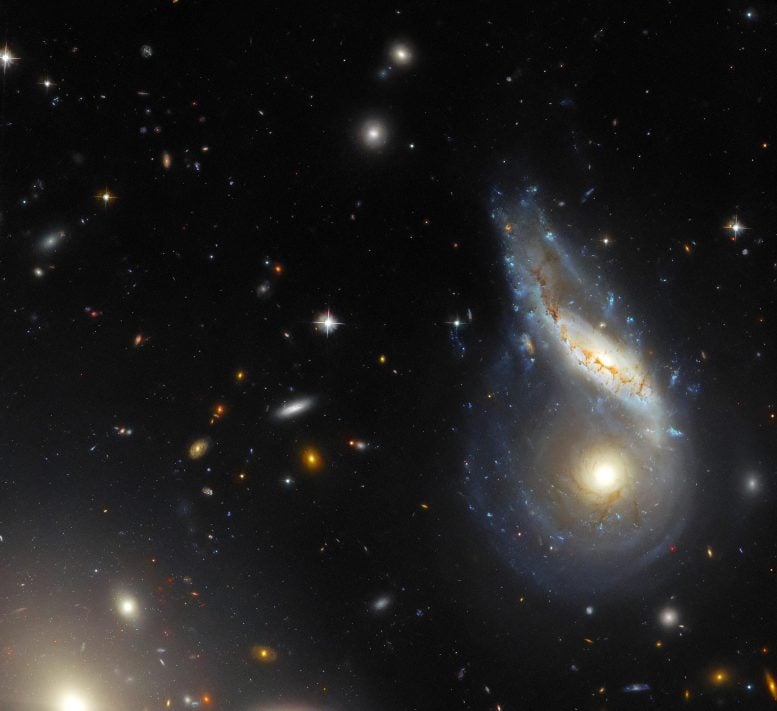
Arp 122, featured in this Hubble Space Telescope image, illustrates the slow, dramatic collision of two galaxies, NGC 6040 and LEDA 59642. This process, occurring 570 million light-years from Earth, highlights the lengthy and transformative nature of galactic mergers. Credit: ESA/Hubble & NASA, J. Dalcanton, Dark Energy Survey/DOE/FNAL/DECam/CTIO/NOIRLab/NSF/AURA, Acknowledgment: L. Shatz
Arp 122, a peculiar galaxy formation comprising two merging galaxies, NGC 6040 and LEDA 59642, located about 570 million light-years from Earth.
This Hubble Picture of the Week features Arp 122, a peculiar galaxy that in fact comprises two galaxies — NGC 6040, the tilted, warped spiral galaxy, and LEDA 59642, the round, face-on spiral — that are in the midst of a collision. This dramatic cosmic encounter is located at the very safe distance of roughly 570 million light-years from Earth. Peeking in at the corner is the elliptical galaxy NGC 6041, a central member of the galaxy cluster that Arp 122 resides in, but otherwise not participating in this monster merger.
Galactic collisions and mergers are monumentally energetic and dramatic events, but they take place on a very slow timescale. For example, the Milky Way is on track to collide with its nearest galactic neighbor, the Andromeda Galaxy (M31), but these two galaxies have a good four billion years to go before they actually meet. The process of colliding and merging will not be a quick one either: it might take hundreds of millions of years to unfold. These collisions take so long because of the truly massive distances involved.
Galaxies are composed of stars and their solar systems, dust, and gas. In galactic collisions, therefore, these constituent components may experience enormous changes in the gravitational forces acting on them. In time, this completely changes the structure of the two (or more) colliding galaxies, and sometimes ultimately results in a single, merged galaxy. That may well be what results from the collision pictured in this image.
Galaxies that result from mergers are thought to have a regular or elliptical structure, as the merging process disrupts more complex structures (such as those observed in spiral galaxies). It would be fascinating to know what Arp 122 will look like once this collision is complete . . . but that will not happen for a long, long time.









MOND people are back with their “wide” narrow binaries. How it scales up to galaxies is a mystery, looks like Beckenstein grafted some known binary features onto MOND and tied it to the edges of galaxies where galactic gravity is supposed to be weak, using only pages of mathematical extradimensional handwaving. Hiding the anomalies until they’re ripe for picking is the royal astronomical M.O. ever since the days of the sun getting eaten by the moon. Is anyone thinking about spin-orbit coupling there besides me? Will they ever get around to finding out there’s a whole lot of surprising spin there? You know Einstein was kind of weak on spin, spooky frame-dragging credit didn’t include him.
Funniest internet gravity hasbara thing I’ve seen all day, fwiw – it wasn’t to keep Einstein from having to say anything about the stuff that Zwicky’s Dunkelmateriel was downplayed until Albert was almost gone, even though Zwicky chose a GR-friendly German word for it, no it was Zwicky’s personality to blame for others who knew about it and didn’t look into it or publicize it. On top of that Zwicky got treated as an object lesson in needing to be a nice guy if you want your gravity-centric ideas to fly in publicity land. So that’s merely how the politics of religious privilege works in the land of gravity “science.”
*Bekenstein* – Might as well get it right.
One way to underestimate stellar spin and frame drag effects with a sling-shot-like capacity would be to suppose that in stronger gravity what happens is the speed of light remains constant, while the rate of time slows, instead of the only alternative, where more gravity means *everything* falls faster.
Forget I ever questioned the chieftains of MONDian nation, they’re all like “Tightest little wide binary systems ever! Can you smell the lensing from here?”
“Arp 122, featured in this Hubble Space Telescope image, illustrates the slow, dramatic collision of two galaxies, NGC 6040 and LEDA 59642.”
So, there are these two spinning things, and they’re about the same size, and it seems the two centers are attracted but the one seen face-on is apparently much denser. It also seems they can stay that size for a long time, so it seems they resemble cells, but behaving oppositely timewise if supposing the heavier one may substantially maintain the same size after adding a ring.
So, it seems this denser galaxy aims overall to draw the other galaxy into a ring that will serve to keep the resulting galaxy size pretty much unchanged and maybe brighten its periphery more than anything else, but beyond that the ring could be too massive to remain in a stable orbit.
Evolution of the system beyond an overly massive ring could include a constricted core that topples to form a new bar. The presumption underlying all of this is the region between the ring and the core is not particularly good at pulling things in, so much as it is effective in keeping things around. The idea simply rolls out of conserving ultra-low energy spin values of gravitational field energy showing ultra-long wavelengths apparent at galactic scales as ripple-like complex field inflections.